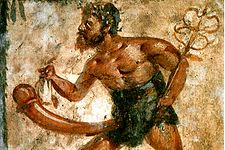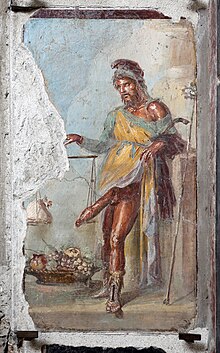|
Priapus
In Greek mythology, Priapus (/praɪˈeɪpəs/;[1] Ancient Greek: Πρίαπος, Príapos) is a minor rustic fertility god, protector of livestock, fruit plants, gardens, and male genitalia. Priapus is marked by his oversized, permanent erection, which gave rise to the medical term priapism. He became a popular figure in Roman erotic art and Latin literature, and is the subject of the often humorously obscene collection of verse called the Priapeia. MythologyRelationship with other deitiesPriapus was described in varying sources as the son of Aphrodite by Dionysus;[2] as the son of Dionysus and Chione;[3] as perhaps the father or son of Hermes;[4] or as the son of Zeus or Pan.[5] According to legend, Hera cursed him with inconvenient impotence (he could not sustain an erection when the time came for sexual intercourse), ugliness and foul-mindedness while he was still in Aphrodite's womb, in revenge for the hero Paris having the temerity to judge Aphrodite more beautiful than Hera.[6] In another account, Hera's anger and curse were because the baby had been fathered by her husband Zeus.[7] The other gods refused to allow him to live on Mount Olympus and threw him down to Earth, leaving him on a hillside. He was eventually found by shepherds and was brought up by them. Priapus joined Pan and the satyrs as a spirit of fertility and growth, though he was perennially frustrated by his impotence. In a ribald anecdote told by Ovid,[8] he attempted to rape the goddess Hestia but was thwarted by an ass, whose braying caused him to lose his erection at the critical moment and woke Hestia. The episode gave him a lasting hatred of asses and a willingness to see them killed in his honour.[9] The emblem of his lustful nature was his permanent erection and his large penis. Another myth states that he pursued the nymph Lotis until the gods took pity on her and turned her into a lotus plant.[10] "Priapos" is a title given to Eros Phanes in the Orphic Hymn to Protogonos, the "firstborn" god of the Greeks who came from the Cosmic Egg.[11] In The Orphic Hymn to Dionysus,[12] Dionysus is given epithets similar to Protogonos and was thought of as the incarnation of Protogonos,[13] so he was considered both the father of fertility god Priapus and also the incarnation of the primordial Priapus. Other worksAs well as the collection known as the Priapeia mentioned above, Priapus was a frequent figure in Latin erotic or mythological verse. In Ovid's Fasti,[14] the nymph Lotis fell into a drunken slumber at a feast, and Priapus seized this opportunity to advance upon her. With stealth he approached, and just before he could embrace her, Silenus's donkey alerted the party with "raucous braying". Lotis awoke and pushed Priapus away, but her only true escape was to be transformed into the lotus tree. To punish the donkey for spoiling his opportunity, Priapus bludgeoned it to death with his gargantuan phallus. When the same story is recounted later in the same book, Lotis is replaced with the virginal goddess Hestia, who avoids being changed into a tree as the other Olympians come to her rescue.[15] Ovid's anecdote served to explain why donkeys were sacrificed to Priapus in the city of Lampsacus on the Hellespont, where he was worshipped among the offspring of Hermes.[16] Once, a donkey that had been given human speech by Dionysus challenged Priapus to a contest about which between them had the better penis. Priapus won the contest, and then killed the donkey, which was put by Dionysus among the stars.[17][18][19] Worship and attributes  The first extant mention of Priapus is in the eponymous comedy Priapus, written in the 4th century BC by Xenarchus. Originally worshipped by Greek colonists in Lampsacus in Asia Minor, the cult of Priapus spread to mainland Greece and eventually to Italy during the 3rd century BC.[20] Lucian (De saltatione) tells that in Bithynia Priapus was accounted as a warlike god, a rustic tutor to the infant Ares, "who taught him dancing first and war only afterwards," Karl Kerenyi observed.[21] Arnobius is aware of the importance accorded Priapus in this region near the Hellespont.[22] Also, Pausanias notes:
In later antiquity, his worship meant little more than a cult of sophisticated pornography.[24] Outside his "home" region in Asia Minor, Priapus was regarded as something of a joke by urban dwellers. However, he played a more important role in the countryside, where he was seen as a guardian deity. He was regarded as the patron god of sailors and fishermen and others in need of good luck, and his presence was believed to avert the evil eye.[25] Priapus does not appear to have had an organized cult and was mostly worshiped in gardens or homes, though there are attestations of temples dedicated to the god. His sacrificial animal was the ass, but agricultural offerings (such as fruit, flowers, vegetables and fish) were also very common.[20] Long after the fall of Rome and the rise of Christianity, Priapus continued to be invoked as a symbol of health and fertility. The 13th-century Lanercost Chronicle, a history of northern England and Scotland, records a "lay Cistercian brother" erecting a statue of Priapus (simulacrum Priapi statuere) in an attempt to end an outbreak of cattle disease.[26] In the 1980s, D. F. Cassidy founded the St. Priapus Church as a modern church centred on worship of the phallus.[27][28] Patron of merchant sailingPriapus' role as a patron god for merchant sailors in ancient Greece and Rome is that of a protector and navigational aide. Recent shipwreck evidence contains apotropaic items carried on board by mariners in the forms of a terracotta phallus, wooden Priapus figure, and bronze sheath from a military ram. Coinciding with the use of wooden Priapic markers erected in areas of dangerous passage or particular landing areas for sailors, the function of Priapus is much more extensive than previously thought.[29] Although Priapus is commonly associated with the failed attempts of rape against the nymphs Lotis and Vesta in Ovid's Fasti[30] and the rather flippant treatment of the deity in urban settings, Priapus' protection traits can be traced back to the importance placed on the phallus in ancient times (particularly his association with fertility and garden protection).[29] In Greece, the phallus was thought of to have a mind of its own, animal-like, separate from the mind and control of the man.[31] The phallus is also associated with "possession and territorial demarcation" in many cultures, attributing to Priapus' other role as a navigational deity.[29] Depictions Priapus' iconic attribute was his priapism (permanently erect penis); he probably absorbed some pre-existing ithyphallic deities as his cult developed. He was represented in a variety of ways, most commonly as a misshapen gnome-like figure with an enormous erect phallus. Statues of Priapus were common in ancient Greece and Rome, standing in gardens. The Athenians often conflated Priapus with Hermes, the god of boundaries, and depicted a hybrid deity with a winged helmet, sandals, and huge erection.[10] Another attribute of Priapus was the sickle which he often carries in his right hand. This tool was used to threaten thieves, doubtless with castration;[32][33] Horace (Sat. 1.8.1–7) writes:[34]
A number of epigrams, apparently written as if to adorn shrines of Priapus, were collected in the Priapeia. In these, Priapus frequently threatens sexual assault against potential thieves:[35]
A number of Roman paintings of Priapus have survived. One of the most famous images of Priapus is that from the House of the Vettii in Pompeii. A fresco depicts the god weighing his phallus against a large bag of coins. In nearby Herculaneum, an excavated snack bar has a painting of Priapus behind the bar, apparently as a good-luck symbol for the customers.[citation needed] Modern derivationsMedical terminologyThe medical condition priapism derives its name from Priapus, alluding to the god's permanently engorged penis. Natural history
See also
ReferencesNotes
Bibliography
External linksWikimedia Commons has media related to Priapus.
|
||||||||||||||||||||||

